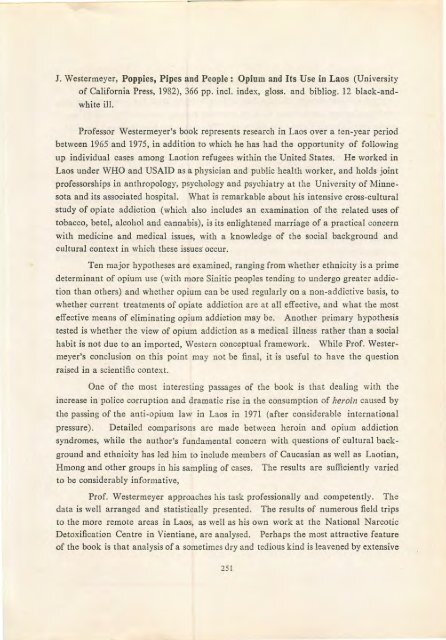The Journal of the Siam Society Vol. LXXII, Part 1-2, 1984 - Khamkoo
The Journal of the Siam Society Vol. LXXII, Part 1-2, 1984 - Khamkoo
The Journal of the Siam Society Vol. LXXII, Part 1-2, 1984 - Khamkoo
Create successful ePaper yourself
Turn your PDF publications into a flip-book with our unique Google optimized e-Paper software.
J. Westermeyer, Poppies, Pipes and People : Opium and Its Use in Laos (University<br />
<strong>of</strong> California Press, 1982), 366 pp. incl. index, gloss. and bibliog. 12 black-andwhite<br />
ill.<br />
Pr<strong>of</strong>essor Westermeyer's book represents research in Laos over a ten-year period<br />
between 1965 and 1975, in addition to which he has had <strong>the</strong> opportunity <strong>of</strong> following<br />
up individual cases among Laotion refugees within <strong>the</strong> United States.<br />
He worked in<br />
Laos under WHO and USAID as a physician and public health worker, and holds joint<br />
pr<strong>of</strong>essorships in anthropology, psychology and psychiatry at <strong>the</strong> University <strong>of</strong> Minnesota<br />
and its associated hospital.<br />
What is remarkable about his intensive cross-cultural<br />
study <strong>of</strong> opiate addiction (which also includes an examination <strong>of</strong> <strong>the</strong> related uses <strong>of</strong><br />
tobacco, betel, alcohol and cannabis), is its enlightened marriage <strong>of</strong> a practical concern<br />
with medicine and medical issues, with a knowledge <strong>of</strong> <strong>the</strong> social background and<br />
cultural context in which <strong>the</strong>se issues· occur.<br />
Ten major hypo<strong>the</strong>ses are examined, ranging from whe<strong>the</strong>r ethnicity is a prime<br />
determinant <strong>of</strong> opium use (with more Sinitic peoples tending to undergo greater addiction<br />
than o<strong>the</strong>rs) and whe<strong>the</strong>r opium can be used regularly on a non-addictive basis, to<br />
whe<strong>the</strong>r current treatments <strong>of</strong> opiate addiction are at all effective, and what <strong>the</strong> most<br />
effective means <strong>of</strong> eliminating opium addiction may be. Ano<strong>the</strong>r primary hypo<strong>the</strong>sis<br />
tested is whe<strong>the</strong>r <strong>the</strong> view <strong>of</strong> opium addiction as a medical illness ra<strong>the</strong>r than a social<br />
habit is not due to an imported, Western conceptual framework. While Pr<strong>of</strong>. Westermeyer's<br />
conclusion on this point may not be final, it is useful to have <strong>the</strong> question<br />
raised in a scientific context.<br />
One <strong>of</strong> <strong>the</strong> most interesting passages <strong>of</strong> <strong>the</strong> book is that dealing with <strong>the</strong><br />
increase in police corruption and dramatic rise in <strong>the</strong> consumption <strong>of</strong> heroin caused by<br />
<strong>the</strong> passing <strong>of</strong> <strong>the</strong> anti-opium law in Laos in 1971 (after considerable international<br />
pressure).<br />
Detailed comparisons are made between heroin and opium addiction<br />
syndromes, while <strong>the</strong> author's fundamental concern with questions <strong>of</strong> cultural background<br />
and ethnicity has led him to include members <strong>of</strong> Caucasian as well as Laotian,<br />
Hmong and o<strong>the</strong>r groups in his sampling <strong>of</strong> cases.<br />
to be considerably informative,<br />
<strong>The</strong> results are sufficiently varied<br />
Pr<strong>of</strong>. Westermeyer approaches his task pr<strong>of</strong>essionally and competently. <strong>The</strong><br />
data is well arranged and statistically presented. <strong>The</strong> results <strong>of</strong> numerous field trips<br />
to <strong>the</strong> more remote areas in Laos, as well as his own work at <strong>the</strong> National Narcotic<br />
Detoxification Centre in Vientiane, are analysed. Perhaps <strong>the</strong> most attractive feature<br />
<strong>of</strong> <strong>the</strong> book is that analysis <strong>of</strong> a sometimes dry and tedious kind is leavened by extensive<br />
251

















